DAVAO CITY (MindaNews / 07 October) — October 17, the first anniversary of President Rodrigo Duterte’s declaration of Marawi City’s “liberation” after a five-month war, is the new target date for the groundbreaking rites that would mark the start of rehabilitation in Marawi’s ‘Ground Zero.’
“Ladies and gentlemen, I hereby declare Marawi City liberated from the terrorist influence that marks the beginning of rehabilitation for the people,” Duterte said on October 17, 2017 amid the ruins of Marawi City.
But it would take a full year for his administration to begin rehabilitation in ‘Ground Zero,’ the heavily devastated 250-hectare, 24-barangay main battle area between government forces and Islamic State-inspired Maute Group and its allies, now referred to as the Most Affected Area (MAA).
The contract for debris management, the first component in the rehabilitation of ‘Ground Zero’ has been awarded to FINMAT International Resources, Inc. (FIRI) through a negotiated procurement, Falconi Millar, Secretary-General of the Housing and Urban Development Coordinating Council and chair of the Selection Committee of the Task Force Bangon Marawi (TFBM) told MindaNews.
Housing Secretary and TFBM chair Eduardo del Rosario had eyed June 2018 for the groundbreaking rites and the return of ‘Ground Zero’ residents back to their villages in the first quarter of 2020, but it has repeatedly been postponed due to failure in negotiations of what would have been a package of projects that would have gone through Swiss Challenge, among other reasons.
Millar told MindaNews on October 1 that they requested for any available date of the President between October 5 and 8 for the groundbreaking but “considering that October 17 is the Marawi liberation anniversary, it may be more meaningful to do it on such date.” On October 3, he said the schedule is “most likely October 17” as all preparations are “geared to that schedule.”
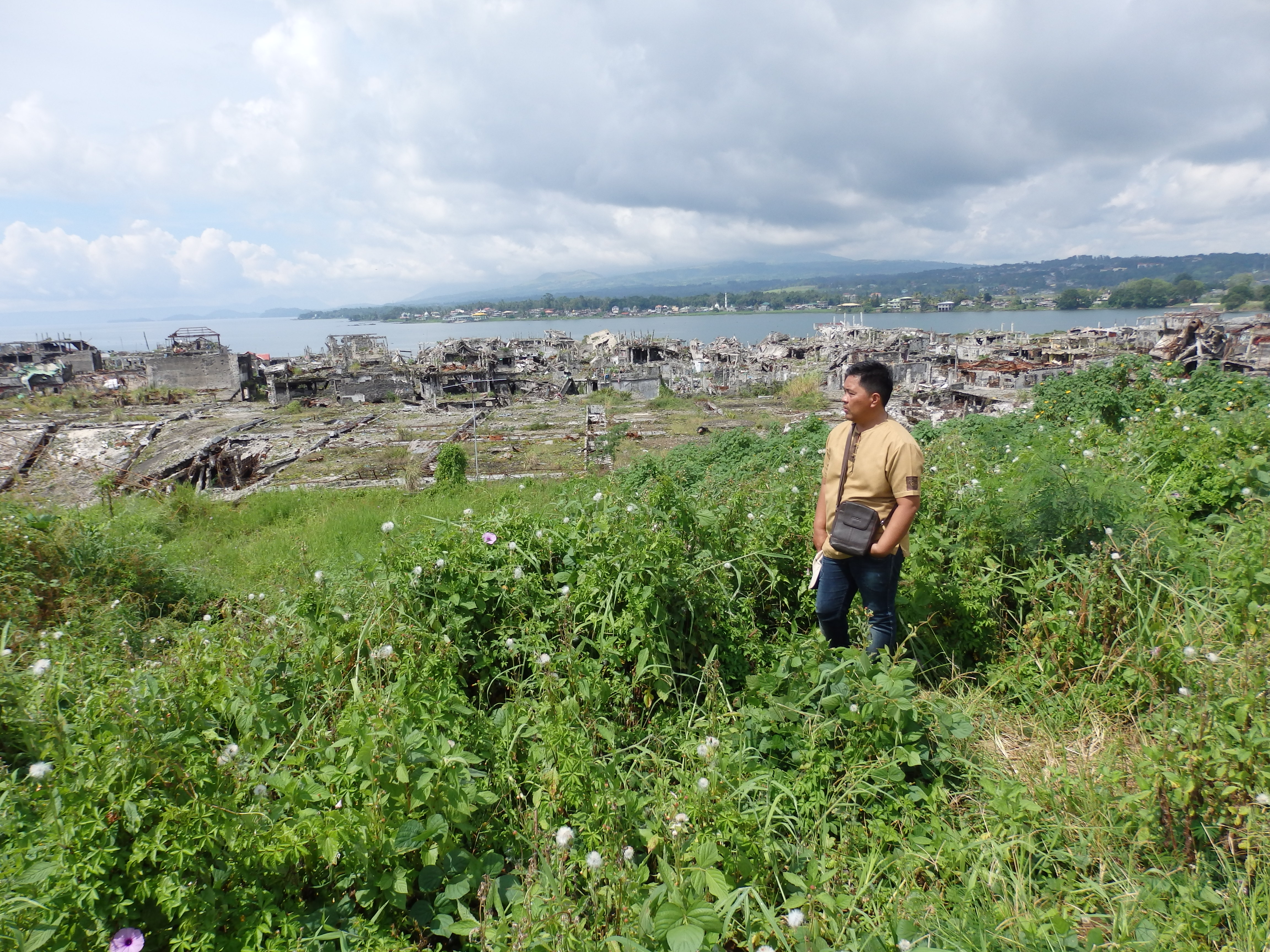 From what used to be the Rizal Park in Marawi City, a resident surveys the rubble of what used to be the Padian, the busy commercial center not only of Marawi but Lanao del Sur on October 2, 2018. President Rodrigo Duterte declared Marawi “liberated from the terrorist influence that marks the beginning of rehabilitation” on October 17, 2017. One year later, rehabilitation of the most affected area has yet to begin. MindaNews photo by CAROLYN O. ARGUILLAS
From what used to be the Rizal Park in Marawi City, a resident surveys the rubble of what used to be the Padian, the busy commercial center not only of Marawi but Lanao del Sur on October 2, 2018. President Rodrigo Duterte declared Marawi “liberated from the terrorist influence that marks the beginning of rehabilitation” on October 17, 2017. One year later, rehabilitation of the most affected area has yet to begin. MindaNews photo by CAROLYN O. ARGUILLAS
The TFBM Field Office in Iligan City is busy preparing for the groundbreaking. Assistant Secretary Felix Castro, TFBM Field Manager, told MindaNews on October 2 that they have identified the venue in the MAA, overlooking Lake Lanao, for the groundbreaking rites.
“I am from Marawi: Let me go home” movement
Displaced residents and civil society organizations on Sunday launched #LetMeGoHomeMovement through social media calling on the government to just allow them to go home as waiting for it to rebuild Marawi has taken so long.
Residents have been displaced for nearly 17 months since May 2017.
“We want the whole world to know that we can no longer wait for the government to rebuild Marawi and thus we are asking that we be allowed to go back to Ground Zero for us to do the rebuilding of our homes,” retired Literature Professor Dalomabi Bula told MindaNews Sunday night
“The hope for the rehabilitation plan of the government has died out. The waiting is too long,” she added.
Eighteen year old Faykha Khayriyyah Alonto Ala, newly elected chair of Barnagay South Madaya Proper who wrote an open letter to TFBM to just fix the road and drainage system in Ground Zero, restore electricity and water just let them go home, said
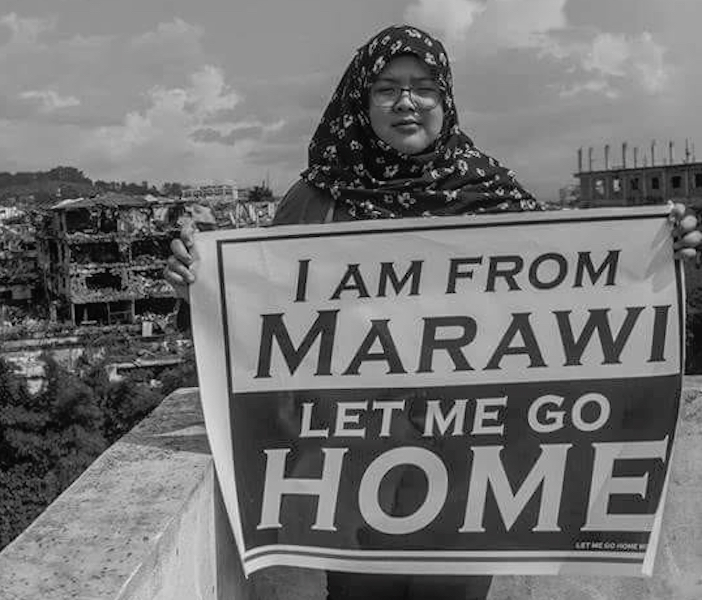 Eighteen year old Faykha Khayriyyah Alonto Ala, newly-elected chair of Barangay South Madaya Proper, Marawi City, displaced from their residence in ‘Ground Zero,’ since May 2017 joins other Meranaws in urging government to let them go home to their villages at the soonest as rehabilitation plans have remained plans a year after President Rodrigo Duterte declared Marawi had been “liberated from the terrorist influence.” Courtesy of the FB page of Ms Ala.
Eighteen year old Faykha Khayriyyah Alonto Ala, newly-elected chair of Barangay South Madaya Proper, Marawi City, displaced from their residence in ‘Ground Zero,’ since May 2017 joins other Meranaws in urging government to let them go home to their villages at the soonest as rehabilitation plans have remained plans a year after President Rodrigo Duterte declared Marawi had been “liberated from the terrorist influence.” Courtesy of the FB page of Ms Ala.
“Too much grand plans, plans that clearly do not have any direction. Let us keep it simple: grant the people their rights to their properties, help them rebuild their lives in the way they want, just our old Marawi, our home,” she told MindaNews Sunday night.
“The process is prolonged because of all the side tracks and ‘palamutis.’ Pag gusto, may paraan, pag ayaw, maraming dahilan. If they really want to help us, they would do it now,” she stressed.
Sector 1, First 5
Millar said “debris management for the first sector is the one that has been initially approved” by the National Housing Authority (NHA) board. It was approved on October 3.
‘Ground Zero’ has been divided into nine sectors, the classification first used in the Kambisita (Visit) project in April-May where displaced residents were allowed three days each to visit their houses and stores and retrieve whatever they can still salvage from the rubble.
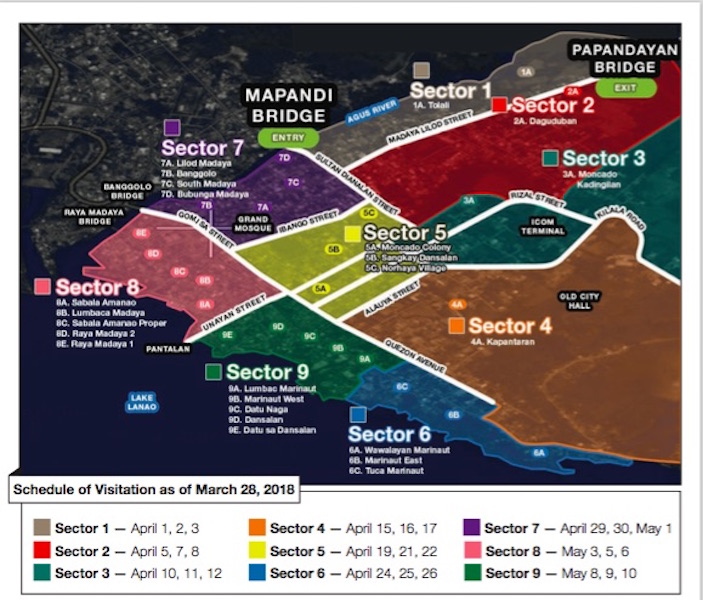 The nine sectors of the 250-hectare, 24-barangay ‘Ground Zero’ as classifired by the Task Force Bangon Marawi
The nine sectors of the 250-hectare, 24-barangay ‘Ground Zero’ as classifired by the Task Force Bangon Marawi
The MAA was classified into nine sectors “to allow optimum usage of time for the rehabilitation” and “allow simultaneous works on sectors already subjected to debris management.”
The first sector comprises only one barangay — Tolali. Marawi has a total of 96 barangays, 24 of them in the MAA.
The cost for the rehabilitation of the entire MAA is P15 billion of which P3.05 billion is for debris management, he said.
The total funding requirement for Ground Zero rehab and the Bangon Marawi Comprehensive Rehabilitation and Recovery Program (BMCRRP) for areas outside ‘Ground Zero,’ as of the 8th All-Agency Meeting of TFBM in August is PhP 86.43 billion. At that time, the funding requirement for MAA rehabilitation was estimated at PhP 17.2 billion and the minimum development requirements listed had reached 23.
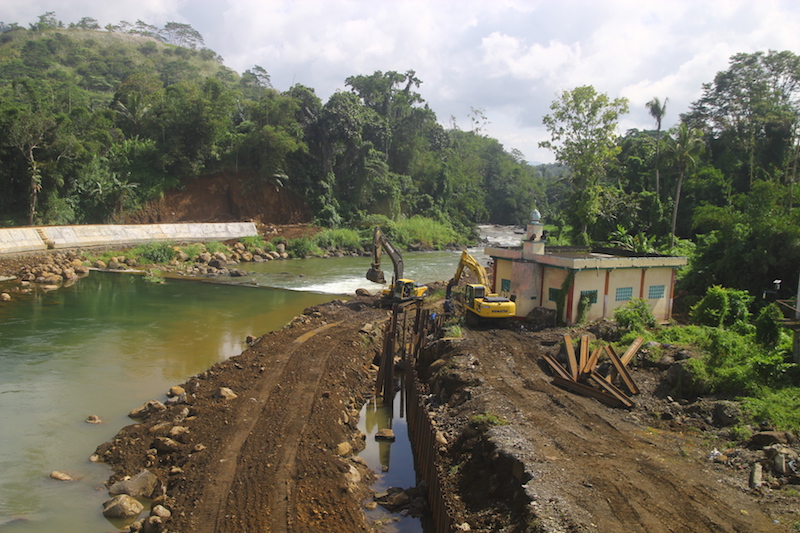 Upon entering the bridge in Mapandi, the first sector for debris management in Marawi City is on the left side, Barangay Tolali which includes this portion where construction is ongoing, for flood control, according to Task Force Bangon Marawi field manager Assistant Secretary Felix Castro. He said it is a project that should have been implemented last year but was overtaken by the Marawi Siege. MindaNews photo by GG BUENO
Upon entering the bridge in Mapandi, the first sector for debris management in Marawi City is on the left side, Barangay Tolali which includes this portion where construction is ongoing, for flood control, according to Task Force Bangon Marawi field manager Assistant Secretary Felix Castro. He said it is a project that should have been implemented last year but was overtaken by the Marawi Siege. MindaNews photo by GG BUENO
Millar said the NHA Board had “approved to utilize emergency provisions of RA 9184 for the first five components” or requirements of the MAA rehabilitation: debris management; site development plan with feasibility study; RROW (road right of way) acquisition; concrete road infrastructure with provision for bike and pedestrian lanes; and provision for underground utilities such as water, power and telecoms.
There is “no Swiss challenge requirement under the emergency provisions of 9184,” Millar said.
Debris management
Debris management involves debris removal, including IEDs and UXOs which had earlier been done by the Armed Forces of the Philippines; demolition works, laydown areas, recycling, handling and disposal of wastes.
Millar said the preservation of historical sites “shall not be touched under the debris management” as it falls under a separate component.
In a press conference in Marawi City on August 24, Secretary Eduardo del Rosario, Housing Secretary and TFBM chair, announced that displaced families from the MAA would be allowed to return to their villages during the “Kambisita 2” on September 10, to establish ownership of the destroyed properties before government starts debris clearing.
The schedule did not push through in September. Millar said it was reset to October 9.
“We have to establish ownership of the lots and the buildings. As of now, we do not know exactly who own the lots and who own the buildings,” del Rosario said, adding they would start from the most affected area. “We have to be very definite, to the nearest inch or meter as we establish it, otherwise we will have future problems,” he said.
During “Kambisita 2,” del Rosario said, they would let individual owners sign the consent (forms) allowing the government to clear their properties. Destroyed buildings will not be touched unless the TFBM gets the consent of the owners,” he assured.
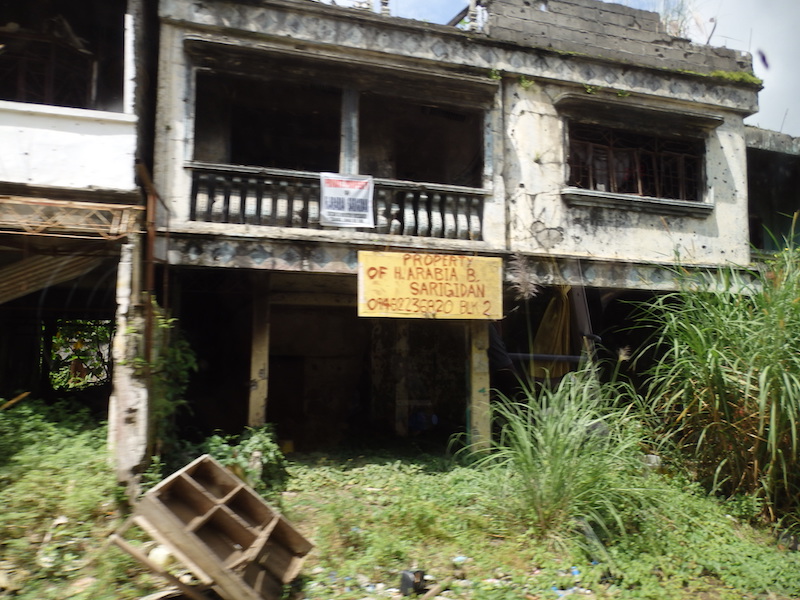 Signages asserting ownership of their houses were put up by displaced residents of Ground Zero during the first Kambisita in April-May 2018. A second Kambisita has been scheduled for October 9 to determine the metes and bounds of the residents’ properties. MindaNews photo by CAROLYN O. ARGUILLAS
Signages asserting ownership of their houses were put up by displaced residents of Ground Zero during the first Kambisita in April-May 2018. A second Kambisita has been scheduled for October 9 to determine the metes and bounds of the residents’ properties. MindaNews photo by CAROLYN O. ARGUILLAS
Millar told MindaNews on Sunday that the Land Resoure sub-committee headed by the Department of Environment and Natural Resources (DENR) “has already incorporated the appropriate waiver and consent in the Kambisita 2.”
He explained that the TFBM “will evaluate each structure” and “all buildings that are classified as nuisance or would pose danger to the life of people undertaking rehab or would impede the flow of the development and rehab shall be acted upon accordingly.”
“All assessments shall be done by the Task Force Bangon Marawi as well as the corresponding demolition as needed,” he said.
According to its website, FINMAT International Resources, Inc. the firm awarded the debris management contract, started its operations in February 1997.
The stockholders of the Pasig City-based corporation, according to its Amended General Information Sheet filed with the Securities and Exchange Corporation, are Reynaldo C. De Jesus, Ma. Teresa R. De Jesus, Veronica Regondola, Jovelyn D. Catimbang, Rhodora O. Reyes, Irene C. De Jesus and Gina R. Bautista,
Among the firm’s completed projects are the General Education Building of the De La Salle University; La Salle College in Antipolo: Robinson Luisita Mall in Tarlac CIty; The Medical City in Pasig City; Philippine Sports Complex in Bulacan; and SMX Expo & Convention Center in Pasay City. Ongoing projects include the Fora Condotel in Tagaytay City; Cuang Migng College Tagaytay; Blue Coral Mactan Beach Resort & Spa in Cebu City; SM Center Lemery in Batangas and Vivaldi Residences in Davao City. (Carolyn O. Arguillas / MindaNews)
